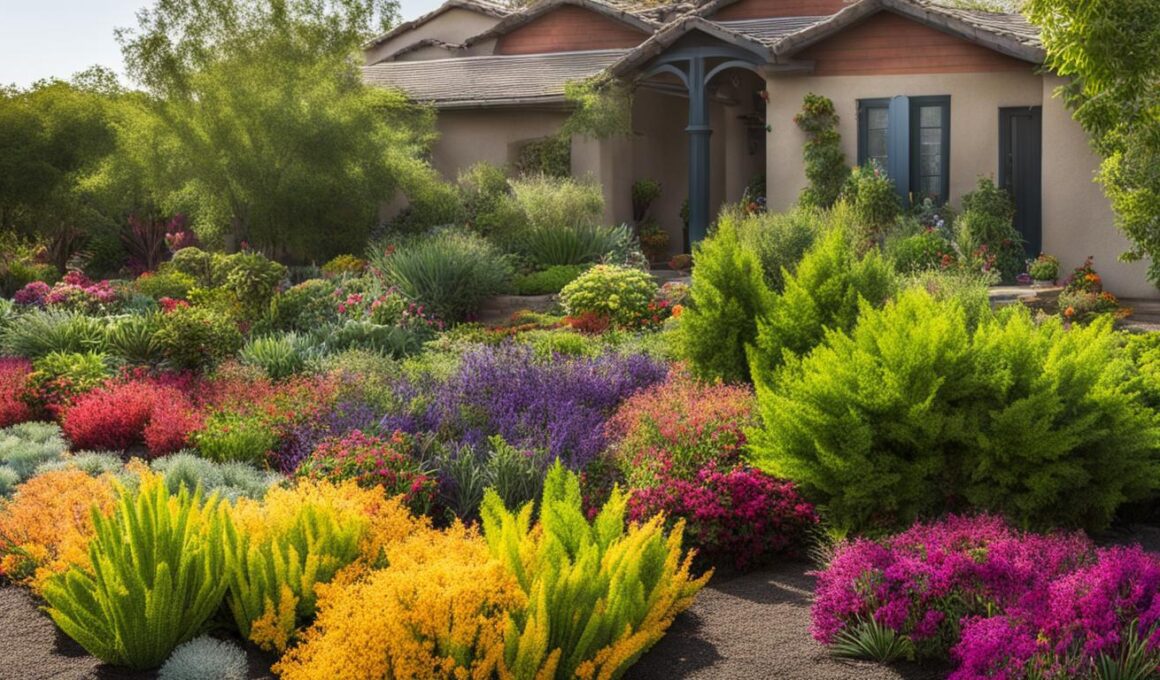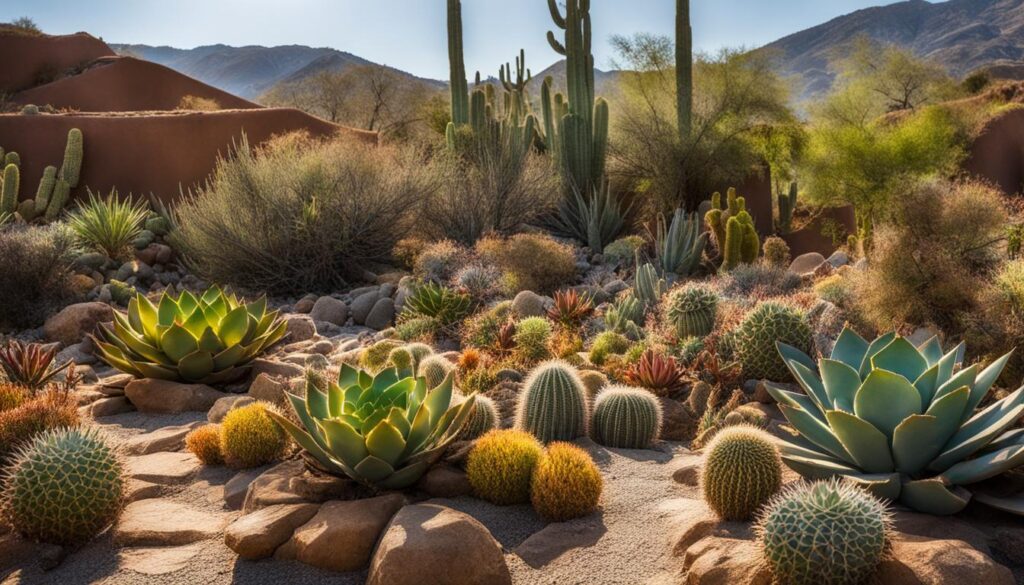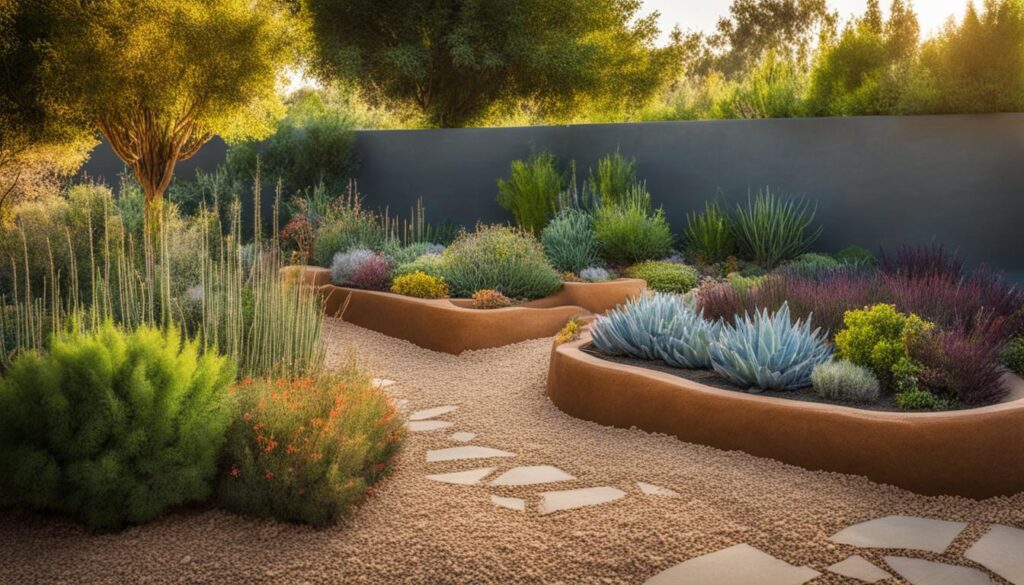Are you looking for ways to create a beautiful garden that thrives in dry climates? With the right knowledge and techniques, you can master the art of drought-tolerant gardening and conserve water while still enjoying a vibrant outdoor space. Implement water-saving gardening techniques, choose drought-resistant plants, create a drought-tolerant garden through xeriscaping, and embrace sustainable gardening methods to create a sustainable and resilient garden that can withstand drought conditions.
Key Takeaways:
- Drought-resistant gardening techniques can help you create a beautiful garden in dry climates.
- Water-saving gardening techniques are essential for conserving water and maintaining a vibrant outdoor space.
- Choosing drought-resistant plants and implementing xeriscaping can help create a sustainable and resilient garden.
- Embracing sustainable gardening methods can minimize water usage and have an eco-friendly approach.
- By mastering drought-resistant gardening techniques, you can save water and keep your garden flourishing despite dry conditions.
Understanding Plant Zones and Earth-Kind Ratings
Before embarking on your journey to create a beautiful drought-tolerant garden, it is crucial to have a solid understanding of plant zones and Earth-Kind ratings. Plant hardiness zones provide valuable information about the climate suitability for different plants in the United States. By knowing your plant zone, you can determine which plants are most likely to thrive in your specific region.
The Earth-Kind rating system evaluates the performance of plants based on heat tolerance, water requirements, pest resistance, and fertilizer tolerance. This rating system helps you select plants that have the characteristics to withstand drought conditions. For example, a plant with a high water requirement may not be suitable for a drought-tolerant garden, while a plant with low water requirements and high heat tolerance would be an excellent choice.
By considering both plant zones and Earth-Kind ratings, you can ensure that the plants you choose are compatible with your climate and have the necessary attributes to thrive in drought conditions. This knowledge will empower you to make informed decisions when selecting plants for your water-wise garden.
Quote: “Understanding plant zones and Earth-Kind ratings is like having a roadmap for creating a successful drought-tolerant garden. It allows you to choose plants that are well-adapted to your climate and will thrive in your garden, even during prolonged periods of drought.” – Gardening Expert
H3: Harnessing the Power of Plant Zones
Plant zones are based on the average minimum winter temperature in a given area. The United States is divided into 13 plant hardiness zones, ranging from Zone 1 with the coldest temperatures to Zone 13 with the warmest. By identifying your plant hardiness zone, you can determine the types of plants that are most likely to survive in your specific climate. This information is invaluable when selecting plants for your drought-tolerant garden.
- List: Benefits of Understanding Plant Zones
- Ensures you choose plants that are adapted to your climate
- Increases the likelihood of plant survival
- Reduces the need for supplemental watering
- Improves overall garden health and resilience
H3: Decoding Earth-Kind Ratings
The Earth-Kind rating system provides further guidance in selecting drought-tolerant plants. When considering different plant options, look for plants with high Earth-Kind ratings, indicating their ability to thrive in challenging conditions. These ratings take into account important factors such as heat tolerance, water requirements, pest resistance, and fertilizer tolerance. By choosing plants with high Earth-Kind ratings, you can enhance the resilience of your garden and ensure its long-term success.
- List: Benefits of Earth-Kind Ratings
- Identifies plants with high heat tolerance
- Helps you select plants with low water requirements
- Highlights plants that are naturally resistant to pests
- Guides you towards plants with minimal fertilizer needs
Armed with knowledge of plant zones and Earth-Kind ratings, you can confidently select plants that will thrive in your drought-tolerant garden. Understanding these concepts will enable you to create a resilient and beautiful outdoor space that conserves water while adding beauty and value to your home.
Drought-Tolerant Plants for Your Garden
When it comes to creating a beautiful and resilient drought-tolerant garden, choosing the right plants is key. Drought-tolerant plants are specially adapted to thrive in dry climates and require minimal watering. By incorporating these plants into your garden, you can conserve water while still enjoying a vibrant and sustainable outdoor space.
One excellent choice for a drought-tolerant garden is Lantana. This colorful flowering plant is known for its ability to withstand hot and dry conditions. It comes in a variety of vibrant colors and attracts pollinators, making it a great addition to any garden.
Another popular option is Salvias and Sages. These plants are not only drought-tolerant but also highly resilient and low-maintenance. They come in a wide range of sizes and blooms, adding both color and texture to your garden.
Cactus is a classic choice for a drought-tolerant garden. These unique plants have evolved to survive in arid environments and require very little water. With their sculptural forms and interesting textures, cacti add a striking visual element to any garden.
Shrimp Plant is another fantastic option for a drought-tolerant garden. This native plant is known for its vibrant and exotic flowers that resemble small shrimp. It thrives in dry conditions and attracts hummingbirds and butterflies, adding life and movement to your garden.
Turk’s Cap is a versatile plant that can tolerate both sun and shade, making it ideal for various areas in your garden. Its beautiful red flowers are not only drought-tolerant but also attract a wide range of pollinators, including bees and hummingbirds.
Native plants should also be considered for a drought-tolerant garden. These plants are adapted to the local climate and are more likely to thrive without the need for excessive watering. Additionally, they support the local ecosystem and promote biodiversity.
By incorporating drought-tolerant plants like Lantana, Salvias and Sages, Cactus, Shrimp Plant, Turk’s Cap, and native species into your garden, you can create a visually stunning and water-wise oasis. These plants will not only survive but thrive in dry conditions, allowing you to conserve water while still enjoying a beautiful and sustainable garden.
Recommended Drought-Tolerant Plants:
- Lantana
- Salvias and Sages
- Cactus
- Shrimp Plant
- Turk’s Cap
- Native Plants
Watering Strategies for Drought-Tolerant Gardens
When it comes to maintaining a successful drought-tolerant garden, implementing effective watering strategies is crucial. Not only will these strategies help conserve water, but they will also ensure the health and vitality of your plants. Here are some key watering techniques to consider:
1. Watering Efficiency:
Promote deeper root growth and water conservation by watering your garden efficiently. Instead of frequent shallow watering, opt for less frequent but deeper watering sessions. This encourages plants to develop stronger and more drought-resistant root systems.
2. Soaker Hoses:
Utilize soaker hoses in your garden to deliver water directly to the plant’s root zone. This efficient method minimizes water loss through evaporation and targets the areas that need it the most. Place the hoses around the base of your plants and let them slowly release water, ensuring maximum absorption.
3. Gray Water:
Consider using gray water, which is wastewater from household activities such as dishwashing, laundry, or showering, to irrigate your garden. Gray water can be a valuable resource for plants, providing nutrient-rich moisture while conserving fresh water. However, it’s important to use environmentally-friendly soaps and avoid using gray water on edible plants.
4. Mulching:
Mulching is an effective way to conserve soil moisture and suppress weed growth in your drought-tolerant garden. Apply a layer of organic mulch, such as wood chips or straw, around your plants to create a protective barrier. This helps reduce evaporation, retain moisture, and keep the soil temperature stable.
Tip: Check your local water regulations and guidelines regarding gray water usage before implementing it in your garden.
By implementing these watering strategies, you can ensure that your drought-tolerant garden thrives while minimizing water consumption. Remember, the goal is to provide your plants with the right amount of water they need, neither too much nor too little. With these techniques in your arsenal, you can enjoy a beautiful and sustainable garden even in the face of water scarcity.
What Are the Best Techniques for Drought-Resistant Gardening in Xeriscape Gardens?
When it comes to maintaining a xeriscape garden drought, there are several techniques that can help. Use native plants, which are naturally adapted to the local climate, and group them according to their water needs. Adding mulch to the soil can also help retain moisture and reduce water evaporation. Additionally, consider using drip irrigation to deliver water directly to the roots of plants.
Prioritizing Water Use in Drought Conditions
In times of drought, it’s crucial to prioritize water use in your garden to ensure the survival and health of your plants. By understanding the specific water requirements of different plants and implementing smart watering strategies, you can effectively conserve water and maintain a thriving garden even in dry conditions.
1. Prioritize Newly Planted Trees and Shrubs
When establishing new trees and shrubs, their root systems are still developing and require regular watering to promote healthy growth. Prioritize watering these plants until their roots are fully established, usually within the first year. Deep and infrequent watering is recommended to encourage deep root growth, allowing the plants to better withstand drought conditions.
2. Focus on Perennial Flowers and Vegetables
Perennial flowers and vegetables have a longer lifespan and require consistent watering during critical stages of growth, such as flowering and fruiting. Prioritize watering these plants to ensure they have the necessary moisture to produce vibrant blooms and bountiful harvests. Utilize shading techniques, such as using shade cloth or companion planting, to reduce evaporation and water loss.
3. Group Plants with Similar Water Needs
Efficiently manage water usage by grouping plants with similar water requirements together in your garden. This allows you to water them effectively without overwatering or underwatering certain plants. By creating specific zones within your garden based on water needs, you can tailor your watering schedule and conserve water while providing each plant with the appropriate moisture.
Remember, it’s important to always adhere to any local water restrictions or guidelines during drought conditions. By prioritizing water use, you can maximize the efficiency of your garden’s water consumption and play your part in conserving this precious resource.
Conclusion
In conclusion, mastering drought-resistant gardening techniques is essential for creating a sustainable garden that thrives despite dry conditions. By implementing water-saving techniques, choosing drought-resistant plants, and prioritizing water use, you can conserve water while still enjoying a beautiful outdoor space.
To create a sustainable garden, it is important to embrace eco-friendly gardening methods and minimize water usage. By understanding plant zones and Earth-Kind ratings, you can ensure that the plants you choose are suitable for your climate and have the ability to withstand drought conditions.
With the right knowledge and techniques, you can create a resilient and vibrant garden that not only conserves water but also supports the local ecosystem and biodiversity. Start implementing these drought-resistant gardening techniques today and watch your garden flourish even in the driest of conditions.













